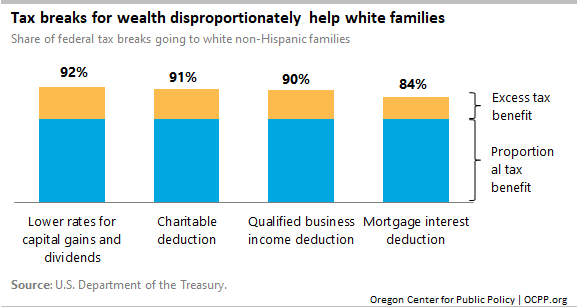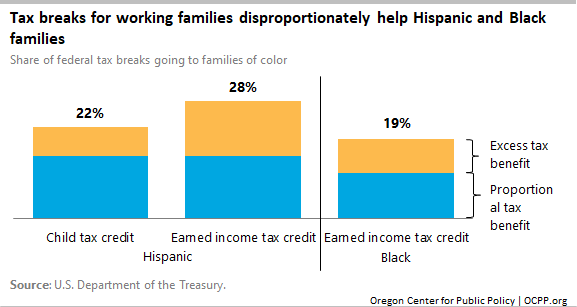Tax breaks — officially called “tax expenditures” — can either help heal the racial divide or worsen it. In other words, tax breaks are not race-neutral.
This was made clear by a recent study released by the U.S. Department of the Treasury. The study provides some of the first estimates of the racial impact of some of the largest tax expenditures in the federal tax code. The study also shows that large numbers of white families benefit greatly from tax expenditures that reduce racial disparities — confirming that equitable policy is good for Black, brown, and white folks.
It’s a dense report, so we have summarized some of the highlights of this important study.
A number of large tax breaks worsen racial inequality
There’s no denying that there is a vast economic inequality by race and ethnicity. The wealthy in this country are overwhelmingly white and white families are also more likely to have higher incomes. None of this happened by accident. Instead, as the Coalition of Communities of Color points out in Addressing the Wealth Gap, “over generations, laws and policies have provided white families with ‘wealth starter kits’ that included ‘land, government-backed mortgages and farm loans, a social safety net, and business and education subsidies.’” Such policies enabled white families to build generational wealth but excluded families of color from the same benefits.
Given this economic reality, it’s not surprising to find that tax breaks structured to benefit those with higher incomes or greater assets disproportionately benefit white families. The Treasury analysis backs this up. White families constituted 67 percent of the tax filers in this data, and yet received:
- Lower rates for capital gains and dividends: 92 percent of the benefits of preferential rates for capital gains and dividends. These function as lower tax rates for the profits someone receives from selling an asset or receiving dividend income from owning an asset.
- Charitable deduction: 91 percent of benefits of the deductibility of charitable contributions. People with tremendous sums of money are more easily able to donate those immense sums and receive tax benefits.
- Qualified business income deduction: 90 percent of the benefits of the qualified business income deduction. The 2017 Trump tax cuts created an additional 20 percent tax break for certain pass-through businesses known as the qualified business income deduction. Since businesses, especially high-sales and high-profit businesses, are disproportionately owned by white people, it’s unsurprising this tax break has this result.
- Mortgage interest deduction: 84 percent of the benefits of the mortgage interest deduction. White families disproportionately own their homes, while Black and Hispanic families are more likely to rent. This, and the way tax deductions interact with tax rates, results in a tax break for having a mortgage on a home, such as the mortgage interest deduction, disproportionately helping white families.

A few key tax breaks help reduce economic inequality by race
Tax expenditures designed to help low-income to middle-income working families disproportionately help families of color. As a baseline, in the Treasury study, Hispanic families were 15 percent of families in this analysis and Black families were 11 percent.
- Earned Income Tax Credit (EITC): The EITC is a refundable credit that supports workers who struggle to get by on low wages. This tax credit disproportionately helped Hispanic families, who received 28 percent of the benefits, and Black families, who received 19 percent.
- Child Tax Credit: This tax credit for families raising children also disproportionately benefited Hispanic families, delivering 22 percent of the benefits, but was more of a wash for Black families at 9 percent. This is likely a function of how the EITC at the federal level is more heavily concentrated in low- to moderate-income families, whereas the Child Tax Credit reaches many higher-income families. Clearly, tax policies that target low- to moderate-income working families are the right places to focus when attempting to reduce racial inequities.

Equitable tax policy is good for white families
While tax expenditures like the EITC and the Child Tax Credit are the kinds of policies that help reduce racial inequality, they also lift up many white families struggling to make ends meet. Roughly half of the beneficiaries of the EITC are white, as are two-thirds of the families benefiting from the Child Tax Credit.

More research is needed in the area of tax policy and race
The Treasury study, while robust, is imperfect. The authors used available data to estimate race based on the tax filer’s name, tax information, and zip code, and due to these limitations could not accurately estimate values for multiracial, Asian, or more specific racial and ethnic groups. While this methodology has been tested in other arenas, it’s not hard to imagine how this is going to misalign with people’s self-reported racial and ethnic identities.
That’s why Oregon has chosen to add an optional question on racial and ethnic identity to state tax forms. This information will allow researchers to further explore how the tax system as a whole, and specific policies, impact racial equity.


Tax breaks are not race-neutral
Tax breaks are not race-neutral
Tax breaks are not race-neutral
Tax breaks — officially called “tax expenditures” — can either help heal the racial divide or worsen it. In other words, tax breaks are not race-neutral.
This was made clear by a recent study released by the U.S. Department of the Treasury. The study provides some of the first estimates of the racial impact of some of the largest tax expenditures in the federal tax code. The study also shows that large numbers of white families benefit greatly from tax expenditures that reduce racial disparities — confirming that equitable policy is good for Black, brown, and white folks.
It’s a dense report, so we have summarized some of the highlights of this important study.
A number of large tax breaks worsen racial inequality
There’s no denying that there is a vast economic inequality by race and ethnicity. The wealthy in this country are overwhelmingly white and white families are also more likely to have higher incomes. None of this happened by accident. Instead, as the Coalition of Communities of Color points out in Addressing the Wealth Gap, “over generations, laws and policies have provided white families with ‘wealth starter kits’ that included ‘land, government-backed mortgages and farm loans, a social safety net, and business and education subsidies.’” Such policies enabled white families to build generational wealth but excluded families of color from the same benefits.
Given this economic reality, it’s not surprising to find that tax breaks structured to benefit those with higher incomes or greater assets disproportionately benefit white families. The Treasury analysis backs this up. White families constituted 67 percent of the tax filers in this data, and yet received:
A few key tax breaks help reduce economic inequality by race
Tax expenditures designed to help low-income to middle-income working families disproportionately help families of color. As a baseline, in the Treasury study, Hispanic families were 15 percent of families in this analysis and Black families were 11 percent.
Equitable tax policy is good for white families
While tax expenditures like the EITC and the Child Tax Credit are the kinds of policies that help reduce racial inequality, they also lift up many white families struggling to make ends meet. Roughly half of the beneficiaries of the EITC are white, as are two-thirds of the families benefiting from the Child Tax Credit.
More research is needed in the area of tax policy and race
The Treasury study, while robust, is imperfect. The authors used available data to estimate race based on the tax filer’s name, tax information, and zip code, and due to these limitations could not accurately estimate values for multiracial, Asian, or more specific racial and ethnic groups. While this methodology has been tested in other arenas, it’s not hard to imagine how this is going to misalign with people’s self-reported racial and ethnic identities.
That’s why Oregon has chosen to add an optional question on racial and ethnic identity to state tax forms. This information will allow researchers to further explore how the tax system as a whole, and specific policies, impact racial equity.
Daniel Hauser
Action Plan for the People
How to Build Economic Justice in Oregon
relevant topics
Struggling families with children take a beating from the Republican budget reconciliation bill
Another harm from the monstrous U.S. House reconciliation bill: less state revenue
SB 120: Amend bill to expand Earned Income Tax Credit
Action Plan for the People
How to Build Economic Justice in Oregon
Latest Posts
Struggling families with children take a beating from the Republican budget reconciliation bill
The Republican budget reconciliation bill leave Oregon children sicker, hungrier, and more likely to live in poverty
Another harm from the monstrous U.S. House reconciliation bill: less state revenue
The reconciliation bill passed by the U.S. House is truly monstrous, slashing health care and nutrition assistance to help pay
SB 120: Amend bill to expand Earned Income Tax Credit
Co-Chair Meek, Co-Chair Nathanson, and Members of the Committee, My name is Daniel Hauser, Deputy Director for the Oregon Center
Your donation helps build Economic Justice in Oregon
Your donation helps build Economic Justice in Oregon